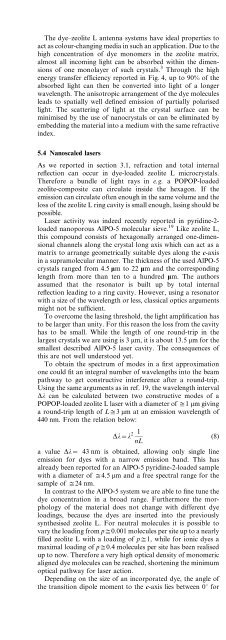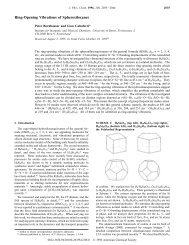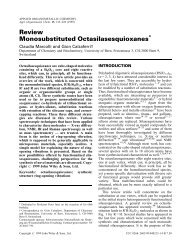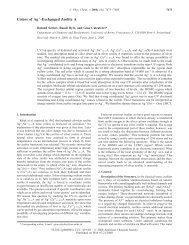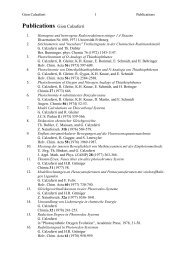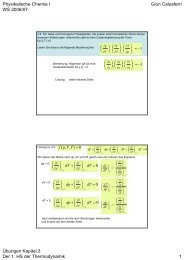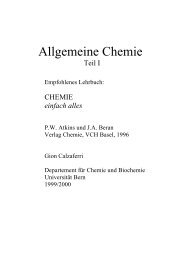Photonic antenna system for light harvesting
Photonic antenna system for light harvesting
Photonic antenna system for light harvesting
Create successful ePaper yourself
Turn your PDF publications into a flip-book with our unique Google optimized e-Paper software.
The dye–zeolite L <strong>antenna</strong> <strong>system</strong>s have ideal properties to<br />
act as colour-changing media in such an application. Due to the<br />
high concentration of dye monomers in the zeolite matrix,<br />
almost all incoming <strong>light</strong> can be absorbed within the dimensions<br />
of one monolayer of such crystals. 3 Through the high<br />
energy transfer efficiency reported in Fig. 4, up to 90% of the<br />
absorbed <strong>light</strong> can then be converted into <strong>light</strong> of a longer<br />
wavelength. The anisotropic arrangement of the dye molecules<br />
leads to spatially well defined emission of partially polarised<br />
<strong>light</strong>. The scattering of <strong>light</strong> at the crystal surface can be<br />
minimised by the use of nanocrystals or can be eliminated by<br />
embedding the material into a medium with the same refractive<br />
index.<br />
5.4 Nanoscaled lasers<br />
As we reported in section 3.1, refraction and total internal<br />
reflection can occur in dye-loaded zeolite L microcrystals.<br />
There<strong>for</strong>e a bundle of <strong>light</strong> rays in e.g. a POPOP-loaded<br />
zeolite-composite can circulate inside the hexagon. If the<br />
emission can circulate often enough in the same volume and the<br />
loss of the zeolite L ring cavity is small enough, lasing should be<br />
possible.<br />
Laser activity was indeed recently reported in pyridine-2loaded<br />
nanoporous AlPO-5 molecular sieve. 19 Like zeolite L,<br />
this compound consists of hexagonally arranged one-dimensional<br />
channels along the crystal long axis which can act as a<br />
matrix to arrange geometrically suitable dyes along the c-axis<br />
in a supramolecular manner. The thickness of the used AlPO-5<br />
crystals ranged from 4.5 mm to22mm and the corresponding<br />
length from more than ten to a hundred mm. The authors<br />
assumed that the resonator is built up by total internal<br />
reflection leading to a ring cavity. However, using a resonator<br />
with a size of the wavelength or less, classical optics arguments<br />
might not be sufficient.<br />
To overcome the lasing threshold, the <strong>light</strong> amplification has<br />
to be larger than unity. For this reason the loss from the cavity<br />
has to be small. While the length of one round-trip in the<br />
largest crystals we are using is 3 mm, it is about 13.5 mm <strong>for</strong> the<br />
smallest described AlPO-5 laser cavity. The consequences of<br />
this are not well understood yet.<br />
To obtain the spectrum of modes in a first approximation<br />
one could fit an integral number of wavelengths into the beam<br />
pathway to get constructive interference after a round-trip.<br />
Using the same arguments as in ref. 19, the wavelength interval<br />
Dl can be calculated between two constructive modes of a<br />
POPOP-loaded zeolite L laser with a diameter of $1 mm giving<br />
a round-trip length of L$3 mm at an emission wavelength of<br />
440 nm. From the relation below:<br />
Dl~l 2 1<br />
(8)<br />
nL<br />
a value Dl~ 43 nm is obtained, allowing only single line<br />
emission <strong>for</strong> dyes with a narrow emission band. This has<br />
already been reported <strong>for</strong> an AlPO-5 pyridine-2-loaded sample<br />
with a diameter of $4.5 mm and a free spectral range <strong>for</strong> the<br />
sample of $24 nm.<br />
In contrast to the AlPO-5 <strong>system</strong> we are able to fine tune the<br />
dye concentration in a broad range. Furthermore the morphology<br />
of the material does not change with different dye<br />
loadings, because the dyes are inserted into the previously<br />
synthesised zeolite L. For neutral molecules it is possible to<br />
vary the loading from p$0.001 molecules per site up to a nearly<br />
filled zeolite L with a loading of p$1, while <strong>for</strong> ionic dyes a<br />
maximal loading of p$0.4 molecules per site has been realised<br />
up to now. There<strong>for</strong>e a very high optical density of monomeric<br />
aligned dye molecules can be reached, shortening the minimum<br />
optical pathway <strong>for</strong> laser action.<br />
Depending on the size of an incorporated dye, the angle of<br />
the transition dipole moment to the c-axis lies between 0u <strong>for</strong><br />
long molecules and 72u <strong>for</strong> smaller ones. There<strong>for</strong>e if a small<br />
molecule is inserted into the channels of zeolite L, part of the<br />
emission will be parallel to the c-axis. Due to the flat and<br />
parallel ends of appropriately prepared zeolite crystals one can<br />
envisage to arrange crystals between two mirrors or to add a<br />
reflecting layer on individual crystals. This might lead to a<br />
microlaser with a plane parallel resonator. Apart from<br />
experimental difficulties the realisation of a dye-loaded zeolite<br />
L nanolaser appears to be feasible.<br />
5.5 Dye sensitised solar cells and LEDs<br />
The currently available solar cells are an attractive source of<br />
renewable energy. They are, however, still expensive <strong>for</strong> large<br />
scale applications. During the last decades some ef<strong>for</strong>t has been<br />
made to find a cheap and efficient alternative <strong>for</strong> crystalline<br />
silicon p/n junctions. Remarkable work has been done on<br />
developing p/n junctions with organic semiconductor materials.<br />
57–59 More groups, however, have focussed on dye sensitisation<br />
of metal oxide semiconductors. 60–63 In this type of dye<br />
sensitised solar cells, the dyes have the function of absorbing<br />
<strong>light</strong> and subsequently injecting an electron in the metal oxide<br />
semiconductor. After electron injection, the dyes have to be<br />
regenerated, usually by means a redox couple. A different kind<br />
of dye sensitised solar cell was proposed by Dexter 64 in 1979.<br />
He described sensitisation of the semiconductor by energy<br />
transfer instead of electron injection, followed by the production<br />
of an electron–hole pair in the semiconductor (Scheme 1).<br />
Although Dexter published this idea in 1979, only a few groups<br />
so far have tried to observe energy transfer from a dye to a<br />
semiconductor. 65–67<br />
The dyes do not have to be regenerated in this case because<br />
they do not exchange electrons. Energy transfer to the semiconductor<br />
works well, if the distance between the donor and<br />
the semiconductor is in the order of the critical distance <strong>for</strong><br />
Förster energy transfer. Only a very thin semiconductor layer is<br />
needed, because the electron–hole pairs <strong>for</strong>m near the surface.<br />
The flexibility in tuning the energy of the donors is large and<br />
only limited by the energy gap of the semiconductor which<br />
must be equal to or smaller than the excitation energy of the<br />
donor. Electron transfer is prevented by introducing a<br />
insulating layer.<br />
The <strong>antenna</strong> effect, as it is found in natural photosynthetic<br />
<strong>system</strong>s, is an attractive tool to increase <strong>light</strong> absorption of<br />
solar cells. Some of the work done on dye sensitisation of<br />
polycrystalline titanium dioxide shows aspects of <strong>antenna</strong><br />
behaviour. 62,68–72 Most of the problems in the <strong>system</strong>s where<br />
an electron is injected into the semiconductor arise in the<br />
regeneration process of the dyes. If the principle of energy<br />
transfer is used instead of electron injection this regeneration<br />
process can be avoided. The photonic <strong>antenna</strong> material<br />
developed in our group is based upon energy migration and<br />
energy transfer and it is challenging to combine its properties<br />
with the ideas of Dexter to <strong>for</strong>m an <strong>antenna</strong>-sensitised solar<br />
cell. It appears to be feasible to put small crystals with a<br />
relatively large diameter with their c-axis perpendicular to the<br />
surface of a semiconductor (see Fig. 21). In this case, of course,<br />
a one directional <strong>antenna</strong> as described in section 4.2 is needed.<br />
The excitation energy is transported to the edge of the crystal<br />
by energy migration. At the edge of the crystal energy transfer<br />
Scheme 1 Citation of D. L. Dexter, J. Lumin., 1979, 18/19, 779. 64b<br />
J. Mater. Chem., 2002, 12, 1–13 11


